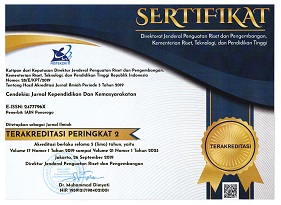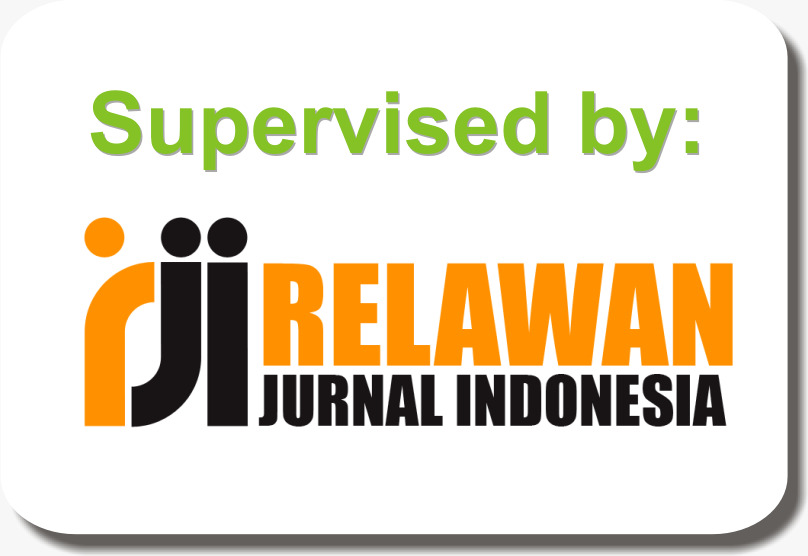MORAL RECONSTRUCTION OF ELEMENTARY EDUCATIONAL LEVEL STUDENTS IN MILLENNIAL ERA: A Scientific Approach Perspective
DOI:
https://doi.org/10.21154/cendekia.v17i1.1579Keywords:
mileneal, model rekonstruksi moral, pendekatan sainstifikAbstract
Abstrak: Penelitian ini bertujuan untuk mendapatkan model rekonstruksi moral siswa jenjang pendidikan dasar era mileneal dari perspektif pendekatan sainstifik. Jenis penelitian ini adalah penelitian diskriptif kualitatif. Pembentukan model dan diskripsi model mengacu pada Kurikulum 2013 jenjang pendidikan dasar. Model rekontruksi moral dibangun secara adaptif berdasarkan langkah-langkah metode Research & Development. Subyek penelitian ini adalah Guru Sekolah Dasar/Madrasah Ibtidaiyah yang sedang studi lanjut pada Magister Program Pendidikan Guru Madrasah Ibtidaiyah Program Pascasarjana IAIN Salatiga, Indonesia. Data penelitian diambil dengan metode observasi, wawancara, angket skala likert. Hasil penelitian menunjukkan bahwa siswa sekolah dasar melakukan pelanggaran moral di lingkungan formal maupun non-formal sebesar 30% per tahun. Analisis kebutuhan konsep model rekonstruksi moral siswa dengan rerata 3.15 termasuk kategori butuh. Model rekonstruksi moral hasil penelitian memiliki tahapan yang secara langsung dapat membangun habituasi nilai-nilai ilmiah dalam perilaku kehidupan sehari-hari siswa, yaitu: mendengar, memperhatikan, komunikasi, kerjasama, bertanya, melakukan, berpikir, saling menghargai, jujur, tanggung jawab dan disiplin.
ملخص: يهد٠هذا البØØ« إلى الØصول على نموذج لإعادة الإعمار الأخلاقي للطلاب ÙÙŠ مستوى التعليم الأساسي ÙÙŠ العصر الØاضر بالمدخل العلمي. والنوع هذا البØØ« هوالبØØ« الوصÙÙŠ النوعي. يشير تشكيل النماذج والأوصا٠النموذجية إلى منهاج 2013 لمستوى التعليم الأساسي. تم بناء نموذج إعادة الإعمار الأخلاقي بالتكي٠على أساس خطوات منهج البØØ« والتطوير. موضوع هذا البØØ« هو معلمي المدارس الابتدائية والثانوية الذي يتّصل الدراسة ÙÙ‰ برنامج الماجستير ÙÙŠ كلّية تربية المعلم المدرسة الإبتدائية بجامعة سلاتيجا الإسلامية الØكومية، اندونيسيا. وأدوات جمع البيانات ÙÙŠ هذا البØØ« هي الملاØظة والمقابلة واالاستبيان بمقياس ليكرت. أظهرت النتائج أن طلاب المدارس الابتدائية ارتكبوا انتهاكات أخلاقية ÙÙŠ البيئات الرسمية وغير الرسمية بنسبة 30 Ùª ÙÙŠ السنة. وتØليل الاØتياجات المÙاهيمية علي نموذج لإعادة الإعمار الأخلاقي للطلاب مع متوسط 3.15 بما ÙÙŠ ذلك Ùئة الØاجة. ÙŠØتوي نموذج لإعادة الإعمار الأخلاقي للطلاب ÙÙŠ هذا البØØ« على مراØÙ„ يمكن أن تبني عادات القيم العلمية ÙÙŠ سلوك Øياة الطلاب اليومية ØŒ وهي: الاستماع، الاهتمام، التواصل، التعاون، العمل، التÙكير، الاØترام، الأمانة، المسؤولية والنشاطة
Downloads
Published
Issue
Section
License
Copyright & License
Please find the rights and licenses in Cendekia: Jurnal Kependidikan dan Kemasyarakatan. By submitting the article/manuscript, the author(s) agree with this policy. No specific document sign-off is required.
1. License
The non-commercial use of the article will be governed by the Creative Commons Attribution license as currently displayed on the Creative Commons Attribution-NonCommercial 4.0 International License.
2. Author(s)' Warranties
The author warrants that the article is original, written by the stated author(s), has not been published before, contains no unlawful statements, does not infringe the rights of others, is subject to copyright that is vested exclusively in the author and free of any third party rights, and that any necessary written permissions to quote from other sources have been obtained by the author(s).
3. User/Public Rights
The spirit of Cendekia: Jurnal Kependidikan dan Kemasyarakatan is to disseminate articles published as free as possible. Under the Creative Commons license, Cendekia: Jurnal Kependidikan dan Kemasyarakatan permits users to copy, distribute, display, and perform the work for non-commercial purposes. Users will also need to attribute authors and Cendekia: Jurnal Kependidikan dan Kemasyarakatan on distributing works in the journal and other media of publications. Unless otherwise stated, the authors are public entities as soon as their articles got published.
4. Rights of Authors
Authors retain all their rights to the published works, such as (but not limited to) the following rights;
- Copyright and other proprietary rights relating to the article, such as patent rights,
- The right to use the substance of the article in own future works, including lectures and books,
- The right to reproduce the article for own purposes,
- The right to self-archive the article,
- The right to enter into separate, additional contractual arrangements for the non-exclusive distribution of the article's published version (e.g., post it to an institutional repository or publish it in a book), with an acknowledgment of its initial publication in this journal (Cendekia: Jurnal Kependidikan dan Kemasyarakatan).
5. Co-Authorship
If the article was jointly prepared by more than one author, any author submitting the manuscript warrants that he/she has been authorized by all co-authors to be agreed on this copyright and license notice (agreement) on their behalf and agrees to inform his/her co-authors of the terms of this policy. Cendekia: Jurnal Kependidikan dan Kemasyarakatan will not be held liable for anything arising due to the author(s) internal dispute. Cendekia: Jurnal Kependidikan dan Kemasyarakatan will only communicate with the corresponding author.
6. Royalties
Being an open accessed journal and disseminating articles for free under the Creative Commons license term mentioned, the author(s) are aware that Cendekia: Jurnal Kependidikan dan Kemasyarakatan entitles the author(s) to no royalties or other fees.
7. Miscellaneous
Cendekia: Jurnal Kependidikan dan Kemasyarakatan will publish the article (or have it published) in the journal if the article's editorial process is completed. The editors of Cendekia: Jurnal Kependidikan dan Kemasyarakatan may modify the paper to a style of punctuation, spelling, capitalization, referencing, and usage that deems appropriate. The author acknowledges that the article may be published so that it will be publicly accessible, and such access will be free of charge for the readers, as mentioned in point 3.

















